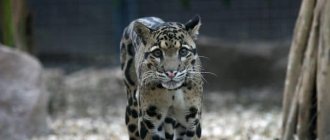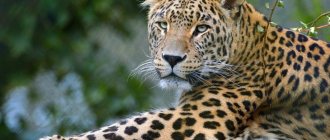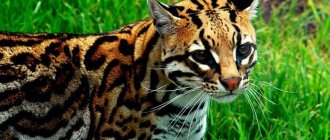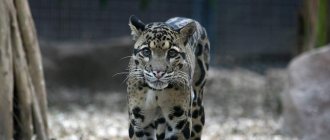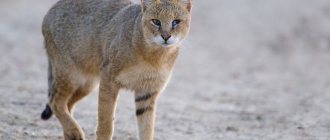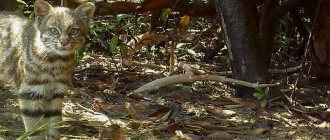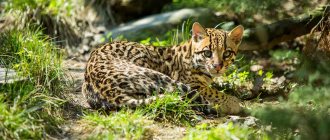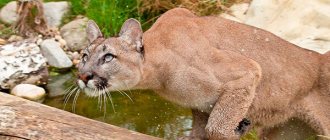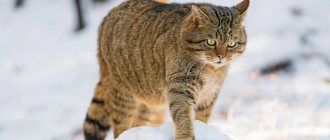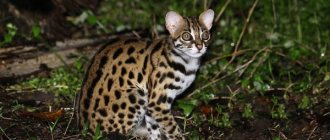The leopard is the most graceful and colorful member of the cat family. This extremely fast and dangerous predator belongs to the cat family and the panther genus. Leopards are notable for their spotted color, which allows them to camouflage well in their habitat. At the moment, most subspecies of leopards are listed in the Red Book as endangered species in need of protection.
Leopard subspecies
In total there are about 8 subspecies of leopards. Let's look at each of them in more detail:
Indochinese leopard
This representative is distinguished by its black color. The species numbers only 2,500 representatives. They live in southeast Asia. Until 2016, they inhabited Singapore, Cambodia and southern China. Due to widespread deforestation, poaching and trade, fur has become extremely rare.
Ceylon leopard
A fairly large subspecies of leopard with a body length of 142 centimeters and a weight of up to 77 kilograms. It lives on the island of Ceylon, which is commonly known as Sri Lanka. There are only 950 individuals in total.
North China leopard
It has a body length of up to 136 centimeters and a weight of about 75 kilograms. Inhabited the mountains and forests of the central and northeastern region of China. A very small species with populations of no more than 348 individuals.
Javan leopard
An endangered subspecies found in Indonesia on the island of Java. Mostly black in color, but sometimes spotted species are also found. The total population of this species is 525 representatives. Extinction occurs due to the reduction of their habitat.
South Arabian leopard
A small representative with a body length of up to 140 centimeters and a weight of 30 kilograms. Notable for its both pale and bright yellow body color. The rosettes on the fur have a patterned structure. For some time, the number of South Arabian leopards was widespread, but since 2008 there are no more than 200 species in the Arabian Peninsula.
Far Eastern leopard
It has several other names: Amur, Korean, Manchurian and East Siberian. The body size is 136 centimeters in length with a weight of no more than 75 kilograms. It differs from other representatives in its long and soft fur texture. During the cold season, the color changes to lighter than in the summer. The area of the lower torso and limbs are painted white. Distributed throughout China, North Korea and the Russian Federation. Literally a hundred years ago it inhabited the entire Korean Peninsula. In 2014 alone, there were 50 representatives of the species. Active measures are being taken to preserve and increase the size of the remaining population.
Persian leopard
This is a fairly large representative of the species with a body length of about 183 centimeters and a weight of up to 60 kilograms. It is distinguished by its dull grayish-orange fur color. The surface of the body is covered with sparse brown spots. Persian leopards have spread throughout Iran, Pakistan, Iran, Turkmenistan and Turkey. In total there are only 1290 representatives of the species. Previously, individuals spread throughout the North Caucasus, but completely disappeared in the mid-20th century.
African leopard
This is the most numerous subspecies. Its body size is about 180 centimeters in length with a weight of up to 90 kilograms. Populated, as the name suggests, the territory of Africa. It chooses various mountains, semi-deserts and tropics as its habitat.
External data of the cat
- The Ocicat is a wild, interesting looking cat. The characteristic muzzle, muscular body, angle of the eyes - all this gives the animal a “predatory look”.
- The Ocicat's body has well-developed muscles, knitted, dense, but not heavy. The sides are flat with rounded ribs. The pelvis and chest are well developed. The neck is flexible, tapering towards the head. An adult cat has a decorative fold of skin on the neck - a dewlap. The back is straight, the pelvis is slightly raised in a straight stance.
- The paws are strong and of medium length. The pads are neat, oval, compactly assembled, the claws are medium. The standards regulate 5 toes on the front paws and 4 on the hind paws. Polyfingeredness is considered a defect and is disqualified.
- The head is triangular in shape, blunted towards the bottom, with a smooth transition from the forehead to the nose. Adult males are characterized by slight sagging cheeks. The muzzle is wide, the lower jaw is strong, strong-willed, with the correct bite. The pods are convex, rounded.
- The ears are large or medium, set moderately high. A slight slope is visible in profile. An additional bonus is the presence of tassels on the ears, which makes them look like a lynx.
- The eyes are almond-shaped, set slightly at an angle. It seems that they are slightly extended towards the ear.
Different pigmentation of the iris is allowed, with the exception of blue - a sign of the recessive gene of Siamese cats.
- The tail is usually long and thin, mobile, with a dark spot at the tip. Any knots or thickening of its shape will lead to disqualification.
Color and fur of the animal
- The wool is thin, smooth, and very soft to the touch. Any manifestation of long hair excludes the breed.
- Agouti's body pattern type is spotted tabby. Also characteristic of the breed is the presence of a pattern in the form of the letter “M” on the forehead, stripes around the paws, on the cheeks, tail and a “necklace” around the neck. On the eyelids, “eyeliner” is noticeable in 2 layers - the inner one is dark and the outer one is light. Also, the chin and upper part of the neck are allowed in a lighter tone.
- The muzzle, back and paws may be slightly darker than the body. The spots on the body should have a clear shape and be visible in different positions.
- The Ocicat boasts an abundance of colors. To avoid confusion, the tone of the animal's coat is determined by the dark tip of the tail.
The standards allow the following colors of spots and the main tone of the animal:
- the spots are black or brown, the main tone is red or copper;
- chocolate, ivory – tone;
- cinnamon – spots, ivory – main color;
- beige-brown spots, pale ivory - base;
- rich blues; light blue or yellow-blue base tone;
- purple spots, light yellow or ivory;
- black, silver or light silver - the base;
- chocolate stains, tone – silver;
- brown, silver;
- blue, silver;
- lilac, silver;
- beige, silver.
The only taboo is the color white. Its presence is possible only when lining the eyes or nose, slightly on the lower jaw or under it.
Black and white leopards
Sometimes there are black leopards, which are also called black panthers. Although their fur color is completely black, they also have spots that are lighter shades of black.
In addition to melanistic leopards, there are also representatives with incomplete melanism or abundism. The spots of this representative are very wide and can merge into one whole. Thus, the black color appears only in certain areas of the animal's fur.
In nature, there are also completely white leopards, which are also called albinos. They are endowed with blue eyes and white coat color, on which spots distinguishable by shade are slightly visible. They are found in southern China or India. Only a few such representatives have appeared in nature reserves around the world.
Natural enemies of leopards
Among animals, wolves are a danger to leopards due to their ability to hunt in packs. There are also encounters with bears, lions, tigers and hyenas.
The main danger to leopards is people, due to the fact that this animal is a coveted hunting trophy, since the predator is one of the most dangerous game animals. Despite ongoing attempts to preserve the population, the problem currently remains unresolved.
general description
Leopards are also called large cats. They are endowed with a very long and strong body, which is slightly narrowed at the sides. The head is small with a characteristic round shape. The ears are small and rounded. The average body size of leopards ranges from 90 to 190 centimeters in length with a tail ranging from 60 to 110 centimeters. The body weight of males ranges from 60 to 75 kilograms. The average weight of a female is almost two times less than the weight of a male.
The animals are remarkable for their characteristic color. Most subspecies do not change coat color depending on the time of year.
The main colors of leopards are yellow and red-yellow with small black spots.
Leopard breeding
Leopards breed depending on their habitat. In the southern territories this happens all year round, in the Far East in the last months of autumn.
The breeding season begins with many fights between adults. Leopard kittens grow quite quickly and by the age of three they practically reach the size of an adult predator.
By this same age, males are ready to reproduce, unlike females, who mature earlier. Cats bear one or two kittens for three months. Females choose protected places as a den, since the cubs are born blind and defenseless.
Distribution area
The habitat of leopards is very wide. However, their numbers in many regions are extremely small. A wide population is distributed throughout Africa, as well as in Asia and some regions of the Arabian Peninsula. Black representatives can be found on the island of Java and Malacca.
Animals prefer vast forest spaces as a habitat. Tropical and deciduous forests, river thickets and mountain slopes are widely inhabited. Some subspecies are found in savannas, steppes and deserts. It is important for them to have some kind of shelter in which there is a sufficient amount of food and the absence of threats from people.
Population and species status
Scientists have noted a steady decline in the total number of leopards in the wild. The main factors that have a negative impact on the populations of these predators are human activity, which leads to a reduction in the food supply. The Javan leopard subspecies inhabiting the island of Java is on the verge of complete extinction.
The Ceylon leopard may face the same fate if serious steps are not taken to restore its numbers. The East Siberian leopard, the Central Asian and South Arabian leopards should be classified as an endangered species.
Nutrition
Leopards are absolutely predatory animals. They feed on a variety of roe deer, antelope and deer. Hunting for their prey is organized near bodies of water. In addition to artiodactyls, leopards can feed on the carcasses of hares, birds and some monkeys. During periods of lack of food, they do not hesitate to eat carrion.
Leopards tend to steal food from each other, since it can stay in the territory of another predator for a long time. As a rule, their shelters are located in root hollows of trees, on scattered stones and in rock overhangs.
Who does the leopard hunt?
Being a typical predator, in most cases the leopard preys on ungulates, but during periods of low food supply, cats can eat birds and reptiles. It is also capable of attacking livestock.
It can also eat carrion and steal prey from other predators, including relatives. Attacks on a person without reason are extremely rare, mostly when they are wounded or cornered. The consequences of such attacks can be very tragic for a person.
The leopard is able to attack wolves and foxes, as well as carry off domestic dogs. They prefer to hunt alone, attacking prey from ambush or sneaking up on it.
Lifestyle and behavior
Big cats are characterized by a solitary lifestyle. They are active at night and spend the day on trees. These predators are also notable for their ability to jump onto rocks and trees up to 5 meters in height. Thanks to their acute vision and hearing, they are excellent at navigating in the dark. And due to their color, they are well camouflaged in their habitat. The only thing that gives them away is their very long tail, which they do not know how to tuck under themselves. Females spend most of their lives with their offspring, while males are solitary throughout their lives.
Leopards are characterized by territorial behavior. The size of the territory of one female can range from 10 to 290 square kilometers, and the territory of a male can reach 1140 square kilometers. They mark their territory with urine and excrement. They also tend to peel off tree bark and make scrapings in the ground.
During the calm period, animals move at a light pace, but are capable of breaking loose, reaching speeds of 60 kilometers per hour. The predators' jumps are 3 meters high and 7 meters long. Leopards are also distinguished by their ability to swim quickly and overcome long distances in water.
Breeding period
It is common for southern representatives to reproduce throughout the year. The inhabitants of the Far East organize the mating season from late autumn to early winter. The mating season is characterized by long fights, which are accompanied by loud roars. The rest of the time the animals are very quiet and calm.
The incubation period lasts for 3 months. Childbirth occurs within 6 hours. From 1 to 3 cubs are born with a body weight of up to 700 grams and a length of up to 15 centimeters. Leopards are born completely blind and covered with thick, long, dark brown fur with spots. Babies develop hearing and vision at the age of one and a half weeks. If the mother senses a potential threat, she quickly hides her cubs away from danger. Already at the age of 6 weeks, leopards begin to leave the den.
Leopard cubs
At first, the mother feeds the offspring with semi-digested meat, and then begins to bring small birds and small mammals. The female cares for the offspring in a specially equipped den, which is located in caves, crevices or blind holes. It is noteworthy that small leopards meow like domestic cats.
The offspring spend time with their mother throughout the year. During this time, she teaches them hunting and survival skills in the wild. After leaving their mother, young leopards stay together for some time.
Animals become sexually mature at the age of two and a half years.
Description of the Asian leopard cat
Adult representatives of Prionailurus bengalensis are the same in size as domestic ones, but more slender. Animals weigh 3.2–4.8 kg in the southern regions of their range, where their number is maximum. The northwest of China is inhabited by small predators weighing 1.5–3.8 kg. The Far Eastern subspecies is much larger: the weight of the cat in winter is 6.8–7.0 kg. The height at the withers does not exceed 40 cm.
External features
The body of the Asian leopard cat is elongated, with an average length of 39–45 cm plus a tail of 17–20 cm. The hind limbs are more powerful and higher than the front ones, which allows the animal to follow the trail of prey for a long time, as well as jump on tree branches.
Interestingly, the cat's toes are slightly webbed. This feature helps the animal swim and also allows it to move on slippery ground.
The head shape is narrow. The dark brown ears are rounded at the ends and have a white spot in the center on the outside. The nose is large, convex, slightly forked. The eyes are large, round, brown. Under the lower eyelids there is a small white spot against a dark background. In its appearance it resembles a tear. Two black-brown stripes go from the eyes to the ears and small light lines go down to the nose. The area around the mouth and mustache is white.
The fur of wild leopard cats has a special spotted pattern.
The Asian leopard cat has short, thick fur. The guard hairs are soft. The main coat color is brown. Shades vary from yellowish and reddish in the southeast of the range to grayish in the north. The body and legs are marked with black spots of varying sizes. The belly, chest and lower part of the neck are white or cream in color and have transverse dark stripes. Along the back, a pattern of dots forms chains resembling lines. The color of large spots is solid or rosette, where the center is lighter and the edges are almost black. The fur from the middle of the tail is decorated with 5–6 pale rings, the tip is dark.
Character
In nature, a nocturnal predator treats humans with distrust and fear, trying in any way to avoid meeting him. Taming these animals is not always successful, especially if the kitten is older than two months. It is possible to establish contact with him only at an early age. Then the baby will forget his forest origins and learn skills for living next to people.
Those with beautiful spotted fur have an independent character. It is admired by its owners. The animals are very affectionate. They love to have their back scratched and their neck stroked. Pets participate in all events taking place in the house and accompany every step of the owner during the day. Having discovered a container of water, the spotted creatures immediately begin to splash around in it. These cats are not afraid to get their fur wet, as they are accustomed to the humid climate in their homeland.
Video: kittens playing with water
The cunning creatures are observant and quickly learn how to turn on the faucet, and can cause a flood if the animals are left unattended. They know how to use the toilet. They love to climb to great heights and jump off deftly without getting injured. They perceive all small objects as prey and carry them around the house in their teeth. Animals are tireless in play, athletic and playful. They know their name and are very trainable. They meow almost like domestic cats, quietly and pleasantly.
But it can be very difficult for owners to adapt to the active lifestyle of their pets. We have to get used to the fact that leopard cats don't sleep at night. This is where the hunting instinct comes into play. Animals require constant human attention, otherwise they will go wild and begin to show aggression towards others. Here is a case of failed domestication. When purchasing a kitten without documents, a resident of the capital of Thailand had no idea about the difficulties he would have to face. A baby named Tiger moved into a multi-storey apartment. There were two other domestic cats in the family. The owners hoped that the kitten would easily make friends with them, learn to use the litter box and get used to people. The newcomer did not like that attention was paid not only to him, but also to other pets. Out of jealousy, the forest animal began to hiss and growl at all the inhabitants of the apartment. He calmed down when petted, but did not give in to hands. Perhaps the reason for this was insufficient daily communication with the owner. Growing up, the pet stopped accepting human affection, became more and more aggressive and began to offend other cats. The owners realized that they could not cope with the animal and took it to a wildlife center for rehabilitation. The cat was already 6 months old. Volunteers had to teach him survival skills before releasing him back into the forest. There, Tiger’s former caregivers were given the address of a nursery where they breed Asian leopard cats for home keeping. Six months later, a tame kitten appeared in the family. He became everyone's favorite and the pride of his owners.
Habitat
The wild Bengal cat is found across a vast territory of two dozen Asian countries. The eastern part of the range begins in Pakistan. Next - India, Bangladesh and states to the south down to Malaysia, as well as the islands of Indonesia. In the west, the Asian leopard cat's home range extends from the Amur River in the Russian Far East to the Philippine Islands. Animals were found in the Himalayas at altitudes of up to 3100 m above sea level. Fans of night hunting cannot stand the heat of +35°C and drought, so they are not found in the steppe regions.
Typical habitats include:
- low-lying river banks;
- tropical rainforests;
- shrubs;
- swamps;
- meadows and pastures;
- agricultural areas.
The hunting territory of one animal is 1.15 km2 in Singapore, where only 89 animals live. This is a minimal site size compared to 2.5 km2 in Malaysia and 3.5 km2 in Borneo. The size depends on the amount of food resources, as well as on human activity in the habitats of the spotted predator. Cats mark their “possessions” by scratching trees and feces all over, and not just along the border.
Asian leopard cat likes to rest in trees
During the day, the dwarf predator sleeps in a shelter, most often in trees. In the evening and at night it hunts, setting up an ambush or tracking prey by smell. The short-haired animal also has sharp eyesight and excellent hearing, which allows it to always be well-fed. Can swim. This ability helped the animal to populate islands located a short distance from each other.
Interestingly, the Asian leopard cat, in pursuit of game, reaches speeds of up to 72.4 kilometers per hour, which is 1.6 times faster than a domestic cat.
This species of spotted animals has adapted better than others to human changes in their habitats. Animals settle in the suburbs, near houses. It's easier to find food here. Forced to hunt in sugar cane fields and other agricultural lands. In Singapore, they come to oil palm plantations after dark in search of food. But the animals spend daytime in the forest, away from people.
Diet of the Asian leopard cat
Prionailurus bengalensis is a carnivorous predator whose diet mainly consists of rodents, small birds, and amphibians. There is information that the animal adds fish and crabs to its menu, which it catches on the sea coast. In tropical rainforests, the Asian leopard cat hunts squirrels, searches for bird nests and eats their eggs. In fields with legumes, root crops, and millet, the animal exterminates mole rats and gophers.
Other victims:
- snakes;
- small ungulates;
- hares;
- wild pigs.
In flooded rice fields, the animal preys not only on rats, but also on slippery eels that live in the water. Occasionally catches insects. The forest robber does not refuse carrion, being the orderly of the jungle.
Video: wild spotted cat eats a rodent
Unlike domestic felines, the small predator never plays with its prey, but immediately eats it. At the same time, without removing feathers or chitinous cover, along with beaks, claws, scales, etc. In these animals, the strength of the dental tissue is maintained until old age.
Reproduction and raising offspring
Asian leopard cats have a mating season at any time of the year. The exception is the Far Eastern subspecies, in which the breeding season begins in March, so that the cubs appear in early June. The rut is preceded by marking activity. Animals meet for procreation once a year. Mating lasts from 5 to 9 days. Only if the kittens die can a leopard cat become pregnant again, but after 4–5 months.
Before the birth of the offspring, the spotted predator prepares a shelter. Selects voids under large stumps, crevices in stones or hollows in tree trunks. Pregnancy lasts 8 weeks with the birth of one cub weighing 120–130 g and 63–70 days if there are 3 kittens in the litter. Usually two survive. In small females, babies are born weighing no more than 75 grams. Newborns are blind and deaf. On the fourth day they can hear, and their eyes open after a week and a half. At first the color of the iris is dark blue, but becomes brown at two months of age.
It's amazing how quickly Asian leopard cat cubs grow and develop. By four weeks they have permanent fangs. Then they begin to eat solid food and leave the den in which they were born. It’s simply hard to believe that even at one month of age, wild kittens are able to run after their mother without showing signs of fatigue.
Wild leopard cat cares for kittens up to 8 months of age
Raising offspring lasts 7–10 months, until the younger generation learns to feed themselves and hide from enemies. Reproductive maturity in Asian leopard cats occurs at one and a half years, when the young animal settles in the chosen territory.
There is no consensus among zoologists about how secretive jungle orderlies take care of their offspring. Most of them claim that the female alone feeds and trains the kittens until they grow up. Other experts are sure that the parents raise the cubs together. The participation of the male provides protection from enemies and provides the kittens with additional food, which increases the survival rate of the offspring by 90%. There is evidence that some couples are monogamous. But most often, after the kittens grow up, the father returns to his territory and continues his solitary existence until the next birth of the cubs. It is difficult to say which hypothesis corresponds to reality. Observing animals in nature is difficult. But the rate of renewal of the population of a species that is being destroyed every day confirms the joint care of these animals for their offspring.
The life expectancy in nature for spotted small cats is only 4 years. The main reason for this is human activity, which hunts them and destroys forests in the tropical jungle. Hundreds of animals die every year on the roads under the wheels of vehicles. Natural enemies are pythons and tigers, but their role in reducing the population is small.
Difference between leopard and jaguar
Leopard and jaguar can be confused. However, they have a number of characteristic differences by which one or another animal can be easily identified. The body of a jaguar is larger and stockier than the build of a leopard. Jaguars also have a much shorter tail, reaching a maximum of 91 centimeters in length, while in leopards it can reach up to 110 centimeters. Another difference is the structure of the head: in jaguars it is larger and more massive, and in the mouth there are large and wide jaws. You can quickly distinguish animals by color. The spots on a jaguar's body are much larger than those of a leopard. In addition, jaguars are distinguished by more saturated and brightly colored fur.
Photo of a jaguar
What the two species have in common is the prevalence of melanism. Leopard and jaguar can be completely black. The name "black panther" can refer equally to both the jaguar and the leopard.
Interesting Facts
- Leopards are considered iconic animals that received special fame among ancient peoples. In Asia, sanctuaries and shrines were built in their honor. Many African tribes considered leopards to be a sacred totem.
- Among leopards there are cannibals. As a rule, they are old and sick animals that are not able to hunt. In the 20s, a case called the “Rudaprayag cannibal” was recorded. In India, a leopard entered a village where it killed 125 people.
- The appearance of the leopard is similar to the Bengal cat. This type of cat is distinguished by its well-developed hunting instinct and formidable character.
Leopards are extremely interesting and mysterious representatives of the fauna, which have some interesting features in their history and way of life.
